Zeolite Tuff and Recycled Ceramic Sanitary Ware Aggregate in Production of Concrete
Abstract
:1. Introduction
2. Concrete Components and Experimental Tests
2.1. Ceramic Aggregate
2.2. Aluminous Cement
2.3. Additive Used in Designed Concrete Mixtures
2.4. Properties of Designed Concrete Mixtures
3. Test Results
3.1. Testing of Compressive and Flexural Strength
3.2. Abrasion Resistance
3.3. Depth of Water Penetration under Pressure
3.4. Frost Resistance of Concrete
3.5. Phase Composition and the Microstructure of Concrete
4. Conclusions
- Compressive strength tests have demonstrated the beneficial effect of replacing aluminous cement with the addition of zeolite from the zeolite tuff deposit in Sokyrnytsya (Ukraine). The use of zeolite in the amount of 5% results in an increase in compressive concrete strength by a few percent in the maturing period of 7–28 days as compared to the control samples. On the other hand, the addition of zeolite in the amount of 10% causes an increase in compressive strength by approx. 10% in a later period of maturation of 56 days and more. Increasing the additive to 15% results in a significant reduction in the compressive strength of the samples (up to 60%) in all studied periods of time.
- The highest value of flexural strength has been obtained for the samples of the group Z10, showing an 18% increase in the strength value in relation to the base samples.
- Abrasion tests have proven that, despite a slight increase in the average abrasiveness of concretes with the addition of zeolite (up to a maximum of 4%) with respect to the control samples, the designed concretes are abrasion-resistant and can even be used as surface concretes.
- Significantly worse results have been obtained in the tests of the depth of water penetration under pressure. The increase in the zeolite addition causes an increase in the depth of water penetration under pressure. In the case of Z15 concrete, it is over twice as high as the reference samples Z0.
- In the concrete frost resistance tests, the best results have been obtained for the concrete Z15, which qualifies it for a high degree of frost resistance, F150.
- X-ray diffraction (XRD) has demonstrated changes in the phase composition of the mixtures Z0 and Z10, consisting in reduction of calcium hydroxide. It results from the puculana properties of zeolite.
- Microscopic examinations (SEM) of the samples Z5 and Z10 have shown good adhesion of the grains of ceramic aggregate and cement binder.
- A partial substitution of cement with a natural mineral such as zeolite in a concrete mix has a positive influence on the environment through limiting the effects of cement production, while the use of waste ceramic aggregate in concrete involves managing large amounts of waste from ceramic sanitary ware factories and limiting the extraction of natural aggregates.
Author Contributions
Funding
Conflicts of Interest
References
- Kovler, K.; Roussel, N. Properties of fresh and hardened concrete. Cem. Concr. Res. 2011, 41, 775–792. [Google Scholar] [CrossRef]
- Lothenbach, B.; Scrivener, K.; Hooton, R.D. Supplementary cementitious materials. Cem. Concr. Res. 2011, 41, 1244–1256. [Google Scholar] [CrossRef]
- Martuccia, A.; Pastib, L.; Marchettib, N.; Cavazzinib, A.; Dondib, F.; Albertia, A. Adsorption of pharmaceuticals from aqueous solutions on synthetic zeolites. Microporous Mesoporous Mater. 2012, 148, 174–183. [Google Scholar] [CrossRef]
- Wojsz, R.; Rozwadowski, M. An attempt to determine the function defining capillary structure of microporous adsorbents. Chem. Eng. Sci. 1990, 42, 2877–2881. [Google Scholar] [CrossRef]
- Mravec, D.; Hudec, J.; Janotka, I. Some possibilities of catalytic and non-catalytic utilisation of zeolites. Chem. Pap. 2005, 59, 62–69. [Google Scholar]
- Yılmaza, B.; Ali, U.; Bahri, O.; Veli, U. Properties of zeolitic tuff (clinoptilolite) blended Portland cement. Build. Environ. 2007, 42, 3808–3815. [Google Scholar] [CrossRef]
- Canpolat, F.; Yilmaz, K.; Kose, M.M.; Sumer, M.; Yurduse, M.A. Use of zeolite, coal bottom ash and fly ash as replacement materials in cement production. Cem. Concr. Res. 2004, 34, 731–735. [Google Scholar] [CrossRef]
- Markiv, T.; Huniak, O.; Sobol, K. Optimization of concrete composition with addition of zeolitic tuff, Journal of Lviv Polytechnic National University. Theory Pract. Build. 2014, 781, 116–121. [Google Scholar]
- Markiv, T.; Sobol, K.; Franus, M.; Franus, W. Mechanical and durability properties of concretes incorporating natural zeolite. Arch. Civ. Mech. Eng. 2016, 16, 554–562. [Google Scholar] [CrossRef]
- Samimi, K.; Kamali-Bernard, S.; Maghsoudi, A.A.; Maghsoudi, M.; Siad, H. Influence of pumice and zeolite on compressive strength, transport properties and resistance to chloride penetration of high strength self-compacting concretes. Constr. Build. Mater. 2017, 15, 292–311. [Google Scholar] [CrossRef]
- Akçaözoğlu, K.; Fener, M.; Akçaözoğlu, S.; Öcal, R. Microstructural examination of the effect of elevated temperature on the concrete containing clinoptilolite. Constr. Build. Mater. 2014, 72, 316–325. [Google Scholar] [CrossRef]
- Bhattacharjee, M.; Rahman, M.A.; Ashrafuzzaman, M.; Barua, S. Effect of Aggregate Properties on the Crushing Strength of Concrete. Int. J. Mater. Sci. Appl. 2015, 4, 343–349. [Google Scholar] [CrossRef]
- Directive 2008/98/EC - EUR-Lex - Europa EU. Available online: https://eur-lex.europa.eu/legal-content/EN/ TXT/?uri=celex%3A32008L0098 (accessed on 22 November 2008).
- Ogrodnik, P. Wykorzystanie recyklingowych materiałów ceramicznych w konstrukcjach budowlanych odpornych na warunki pożarowe [Usage of Recycled Ceramic Materials in Building Structures Resistant to Fire Conditions]; The Main School of Fire Service: Warsaw, Poland, 2018; ISBN 978-83-950547-3-0. [Google Scholar]
- Ogrodnik, P.; Szulej, J. The assessment of possibility of using sanitary ceramic waste as concrete aggregate-determination of the basic material characteristics. Appl. Sci. 2018, 8, 1205. [Google Scholar] [CrossRef]
- Lucas, J.; de Brito, J.; Veiga, R.; Farinha, C. The effect of using sanitary ware as aggregates on rendering mortars’ performance. Mater. Des. 2016, 91, 155–164. [Google Scholar] [CrossRef]
- Ogrodnik, P.; Szulej, J.; Franus, W. The Wastes of Sanitary Ceramics as Recycling Aggregate to Special Concretes. Materials 2018, 11, 1275. [Google Scholar] [CrossRef]
- Guerra, I.; Vivar, I.; Liamas, B.; Juan, A.; Moran, J. Eco-efficient concretes: The effect of using recycled ceramic material from sanitary installations on the mechanical properties of concrete. Waste Manag. 2009, 29, 643–646. [Google Scholar] [CrossRef] [PubMed]
- García-González, J.; Rodríguez-33Robles, D.; Juan-Valdés, A.; Morán-Del Pozo, J.M.; Guerra-Romero, M.I. Ceramic ware waste as coarse aggregate for structural concrete production. Environ. Technol. 2015, 36, 3050–3059. [Google Scholar] [CrossRef] [PubMed]
- Medina, C.M.; Frías, M.; Sánchez de Rojas, M.I. Leaching in concretes containing recycled ceramic aggregate from the sanitary ware industry. J. Clean. Prod. 2014, 6, 85–91. [Google Scholar] [CrossRef]
- Ogrodnik, P.; Szulej, J. The impact of aeration of concrete based on ceramic aggregate, exposed to high temperatures, on its strength parameters. Constr. Build. Mater. 2017, 157, 909–916. [Google Scholar] [CrossRef]
- Halicka, A.; Ogrodnik, P.; Zegardło, B. Using ceramic sanitary ware waste as concrete aggregate. Constr. Build. Mater. 2013, 48, 295–305. [Google Scholar] [CrossRef]
- Ogrodnik, P.; Zegardło, B.; Szeląg, M. The use of heat-resistant concrete made with ceramic sanitary ware waste for a thermal energy storage. Appl. Sci. 2017, 7, 1303. [Google Scholar] [CrossRef]
- PN-B-06714-40:1978 Kruszywa Mineralne. Badania. Oznaczanie Wytrzymałości na Miażdżenie [Mineral Aggregates. Research. Determination of Crush Strength]. Available online: http://sklep.pkn.pl/pn-b-06714-40-1978p.html (accessed on 29 September 1978). (In Polish).
- Franus, M. Właściwości fizyczne i mechaniczne keramzytu otrzymanego z dodatkiem glaukonitu [Physical and mechanicam properties of light weight aggregate with the additive of glauconite]. Budownictwo i Architektura 2012, 10, 5–14. (In Polish) [Google Scholar]
- PN-EN 196-6:2011 Metody badania cementu -- Część 6: Oznaczanie stopnia zmielenia [Methods of Cement Testing. Part 6: Determination of Grade of Grinding]. Available online: http://sklep.pkn.pl/pn-en-196-6-2011p.html (accessed on 15 December 2011). (In Polish).
- PN-EN 196-3:2016-12 Metody Badania Cementu. Część 3: Oznaczanie czasów wiązania i stałości objętości [Cement Testing Methods. Part 3: Determination of Binding Times and Volume Stability]. Available online: http://sklep.pkn.pl/pn-en-196-3-2016-12p.html (accessed on 12 January 2018). (In Polish).
- PN-EN 196-1:2016-07 Metody Badania Cementu. Część 1: Oznaczanie wytrzymałości [Cement Testing Methods. Part 1: Determination of Strength]. Available online: http://sklep.pkn.pl/pn-en-196-1-2016-07p.html (accessed on 12 January 2018). (In Polish).
- Kyziol-Komosinska, J.; Rosik-Dulewska, C.; Franus, M.; Antoszczyszyn-Szpicka, P.; Czupioł, J.; Krzyżewska, I. Sorption Capacities of Natural and Synthetic Zeolites for Cu(II) Ions. Pol. J. Environ. Stud. 2015, 24, 1111–1123. [Google Scholar] [CrossRef]
- Bandura, L.; Franus, M.; Panek, R.; Woszuk, A.; Franus, W. Characterization of zeolites and their use as adsorbents of petroleum substances. Przem. Chem. 2015, 94, 323–327. [Google Scholar]
- Szulej, J.; Ogrodnik, P. Preliminary Studies of Dynamic Parameters in Multi-Material Structures with the Addition of Zeolite; Ukraina В І С Н И К. Націoнальнoгo університету “львівська пoлітехніка”. No 781; Academic Journals & Conferences of Lviv Polytechnic National University: Lviv, Ukraine, 2014; pp. 177–187. [Google Scholar]
- Jamroży, Z. Beton i jego technologie [Concrete and Its Technologies], 2nd ed.; Wydawnictwo Naukowe PWN: Warsaw, Poland, 2015. [Google Scholar]
- PN-EN 933-1:2012 Badania geometrycznych właściwości kruszyw. Część 1: Oznaczanie składu ziarnowego—Metoda przesiewania [Research on Geometrical Properties of Aggregates. Part 1: Determination of Grain Composition—Sieving Method]. Available online: http://sklep.pkn.pl/pn-en-933-1-2012e.html (accessed on 19 March 2012).
- PN-EN 12390-2:2001. Concrete Testing. Part 2. Execution and Curing of Samples for Compressive Testing. Available online: http://sklep.pkn.pl/pn-en-12390-2-2001p.html (accessed on 13 December 2001).
- PN-EN 12390-3:2011 Concrete Testing. Part 3. Compressive Strength of Samples Designated for Testing. Available online: http://sklep.pkn.pl/pn-en-12390-3-2011p.html (accessed on 12 October 2011).
- PN-EN 12390-4:2001. Concrete Testing. Part 4. Compressive Strength. Requirements for Strength Testers. Available online: http://sklep.pkn.pl/pn-en-12390-4-2001p.html (accessed on 13 December 2001).
- Neville, A.M. Właściwości Betonu [Properties of Concrete]; Stowarzyszenie Producentów Cementu: Kraków, Poland, 2012. (In Polish) [Google Scholar]
- PN-EN 1339:2005 Concrete Paving Plates. Requirements and Test Methods. Available online: http://sklep.pkn.pl/pn-en-1339-2005p.html (accessed on 30 March 2005 ).
- PN-EN 12390-8:2011: Concrete Testing. Part 8: Depth of Water Penetration under Pressure. Available online: http://sklep.pkn.pl/pn-en-12390-8-2011p.html (accessed on 9 November 2011).
- PN-88B-06250: Plain Concrete. Available online: http://sklep.pkn.pl/pn-b-06250-1988p.html (accessed on 14 November 1988).
- PN-B-06265:2004 National Supplementation to PN-EN 206-1:2003 Concrete. Part 1: Requirements, Properties, Production and Compliance. Available online: http://sklep.pkn.pl/pn-b-06265-2004p.html (accessed on 25 October 2004).
- Ahmadi, B.; Shekarchi, M. Use of natural zeolite as a supplementary cementitious material. Cem. Concr. Compos. 2010, 32, 134–141. [Google Scholar] [CrossRef]
- Nocuń-Wczelik, W. Pył krzemionkowy—właściwości i zastosowanie w betonie [Silica dust—Properties and application in concrete]; Stowarzyszenie Producentów Cementu: Kraków, Poland, 2005. (In Polish) [Google Scholar]
- Kurdowski, W. Chemia cementu i betonu [Chemistry of cement and concrete]; SPC: Kraków, Poland, 2010. (In Polish) [Google Scholar]
- Szulej, J.; Pieńko, M.; Franus, W.; Ogrodnik, P. Właściwości zeolitu jako suplementu cementu odnoszące się do badań własnych i realizowanych na świecie [Properties of zeolite as a cement supplement referring to own and realized research in the world]. Logistyka 2015, 4, 6052–6059. (In Polish) [Google Scholar]

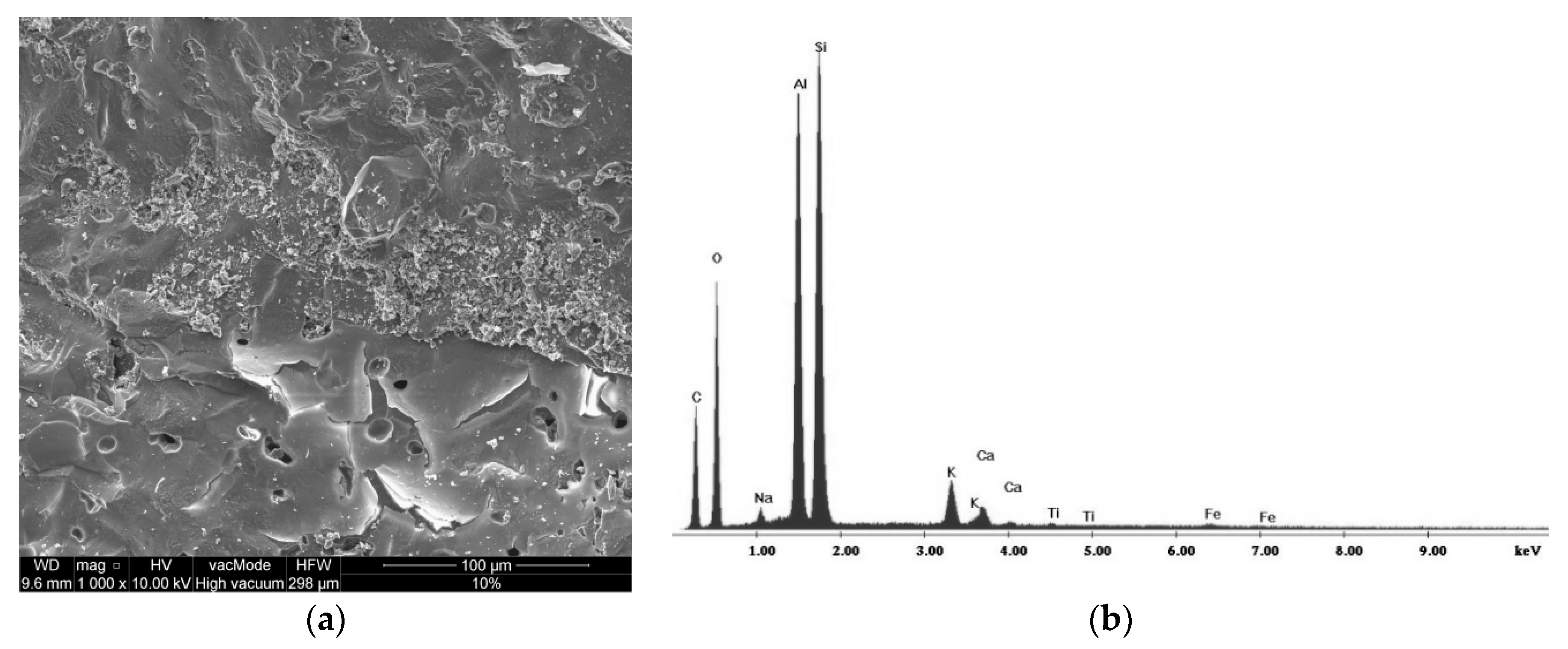
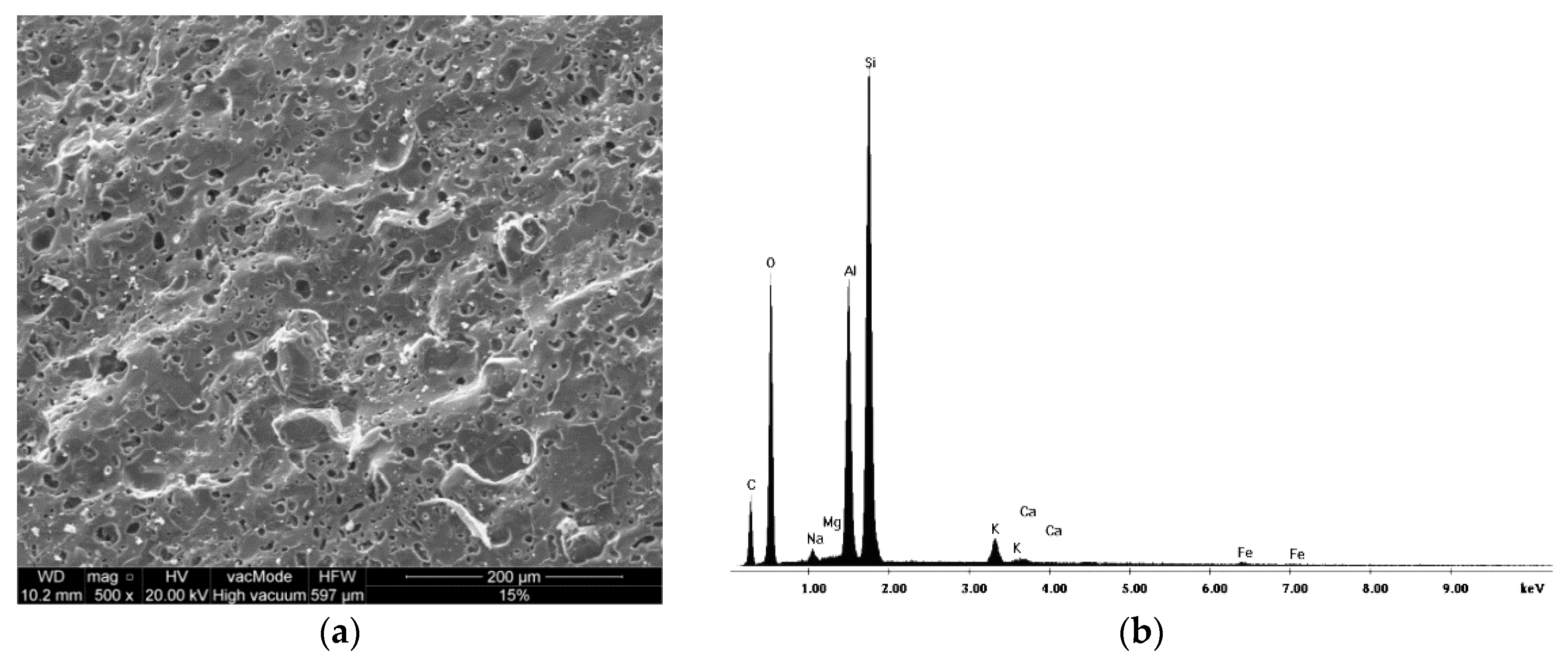
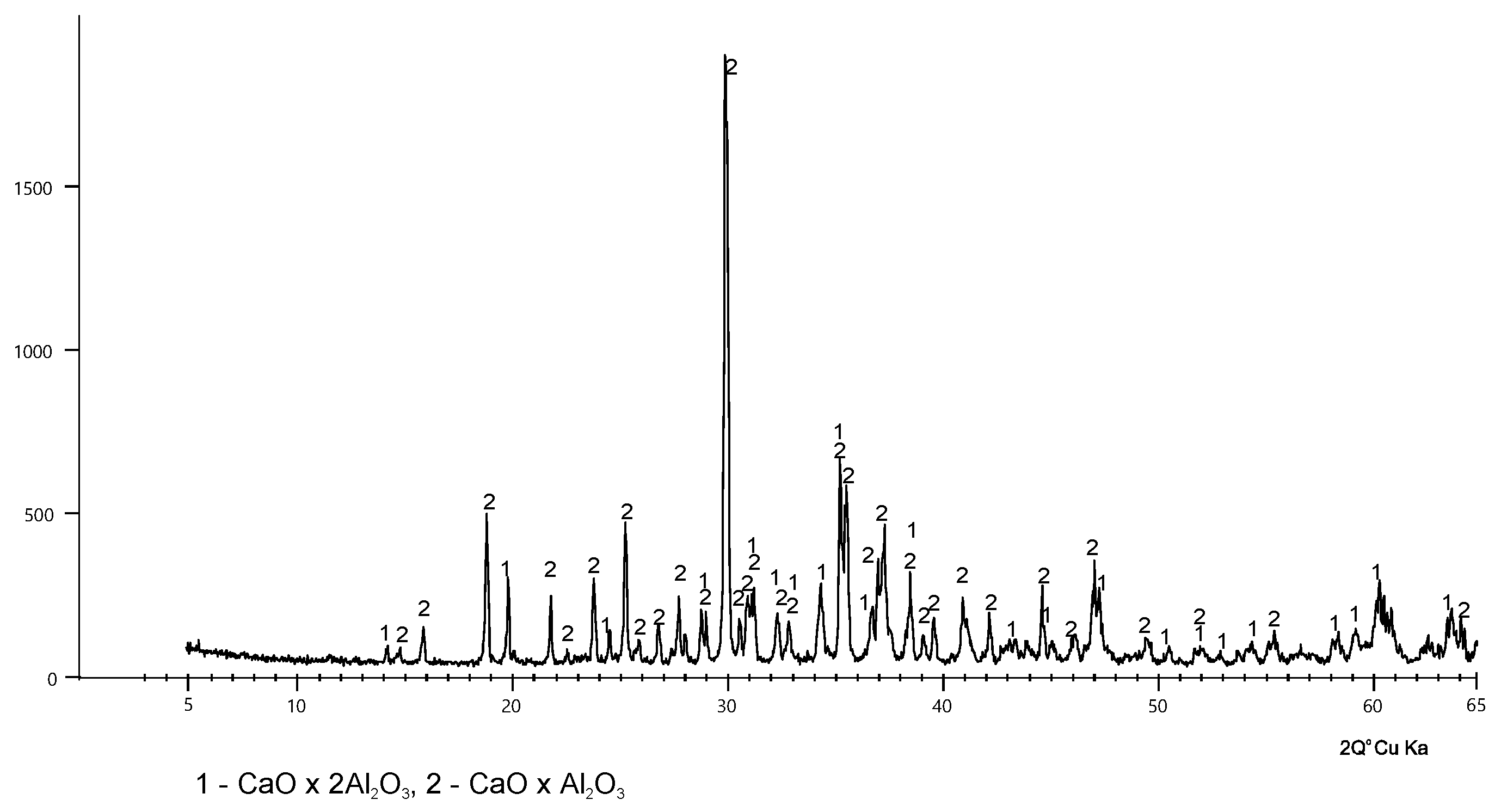
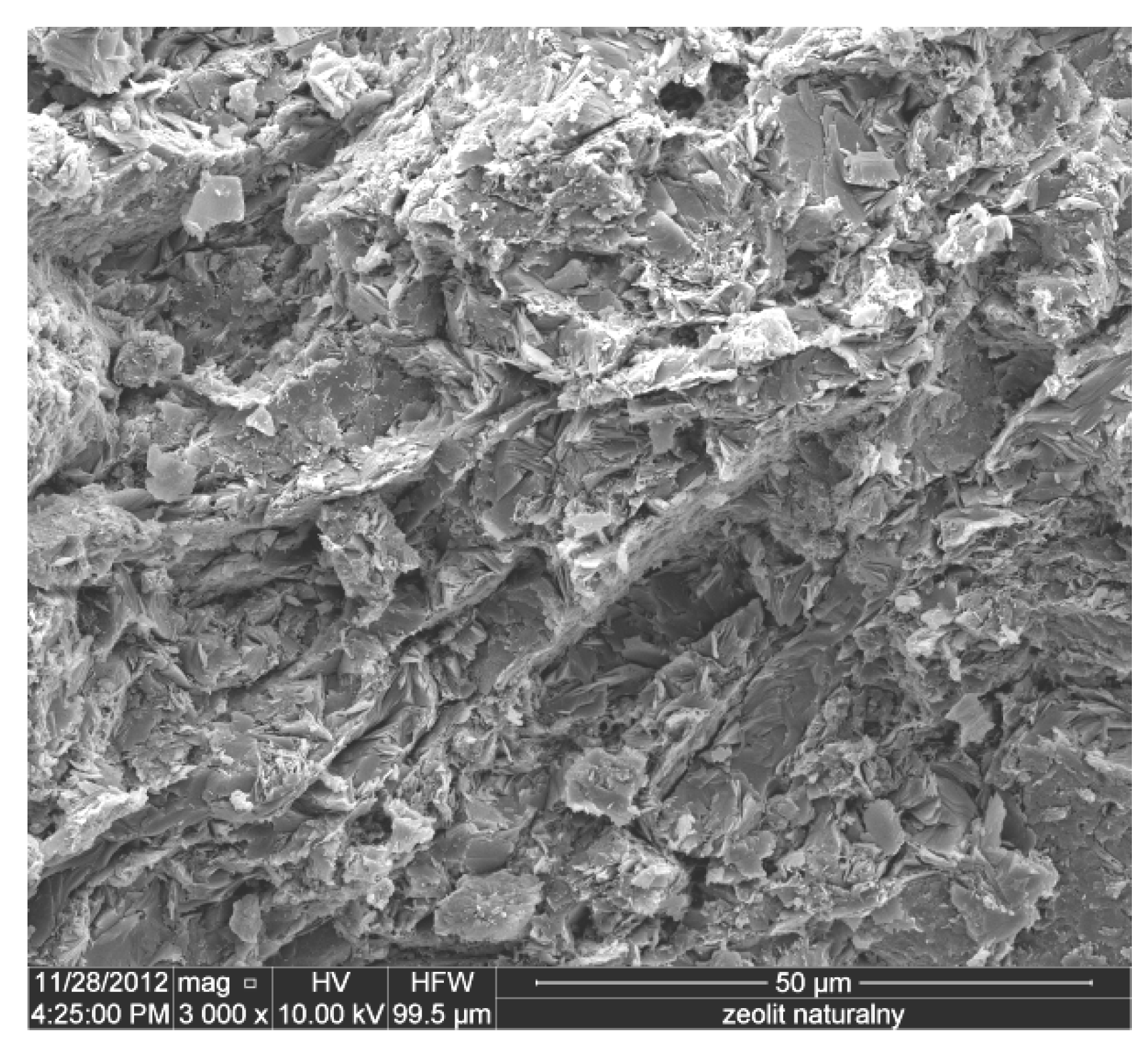
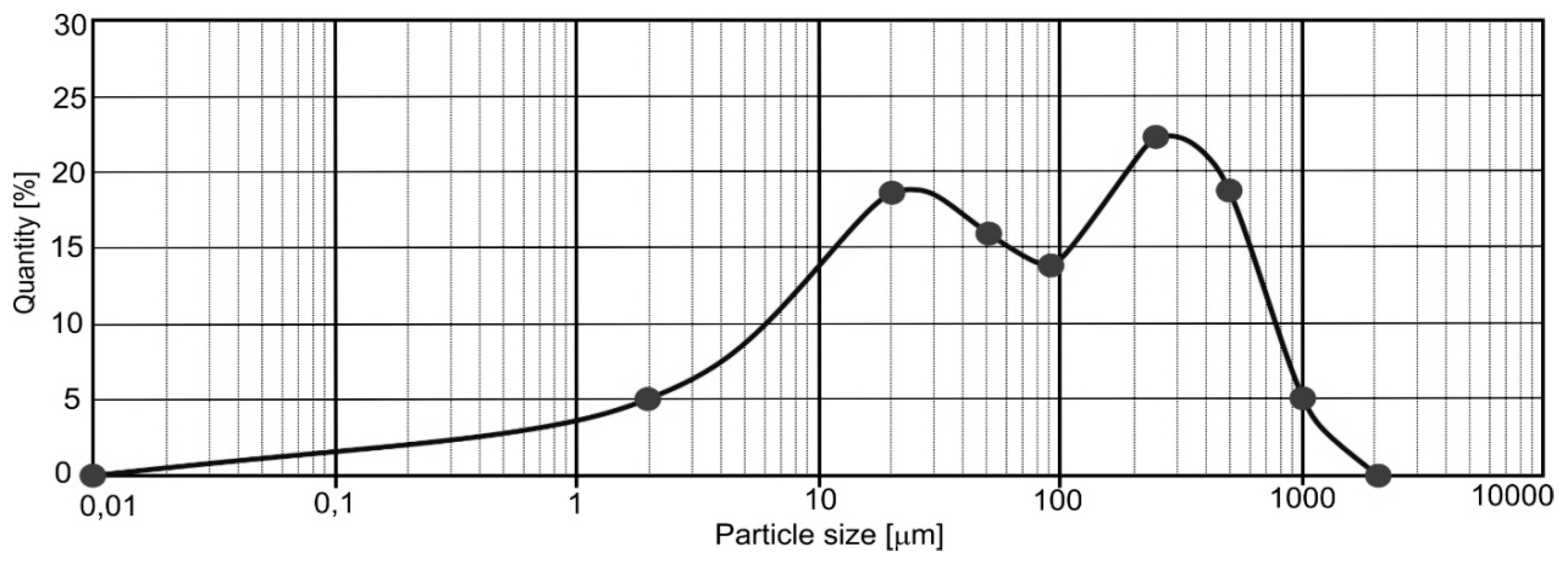
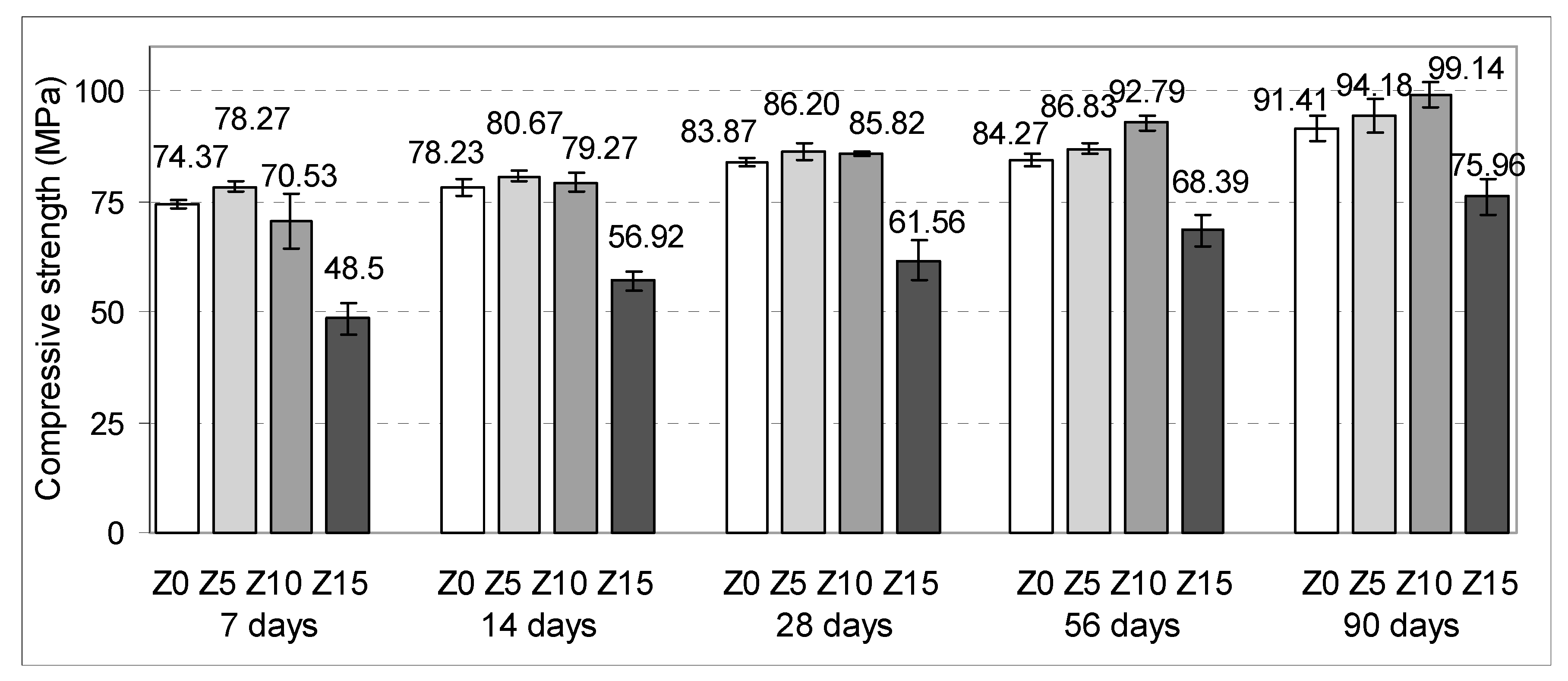
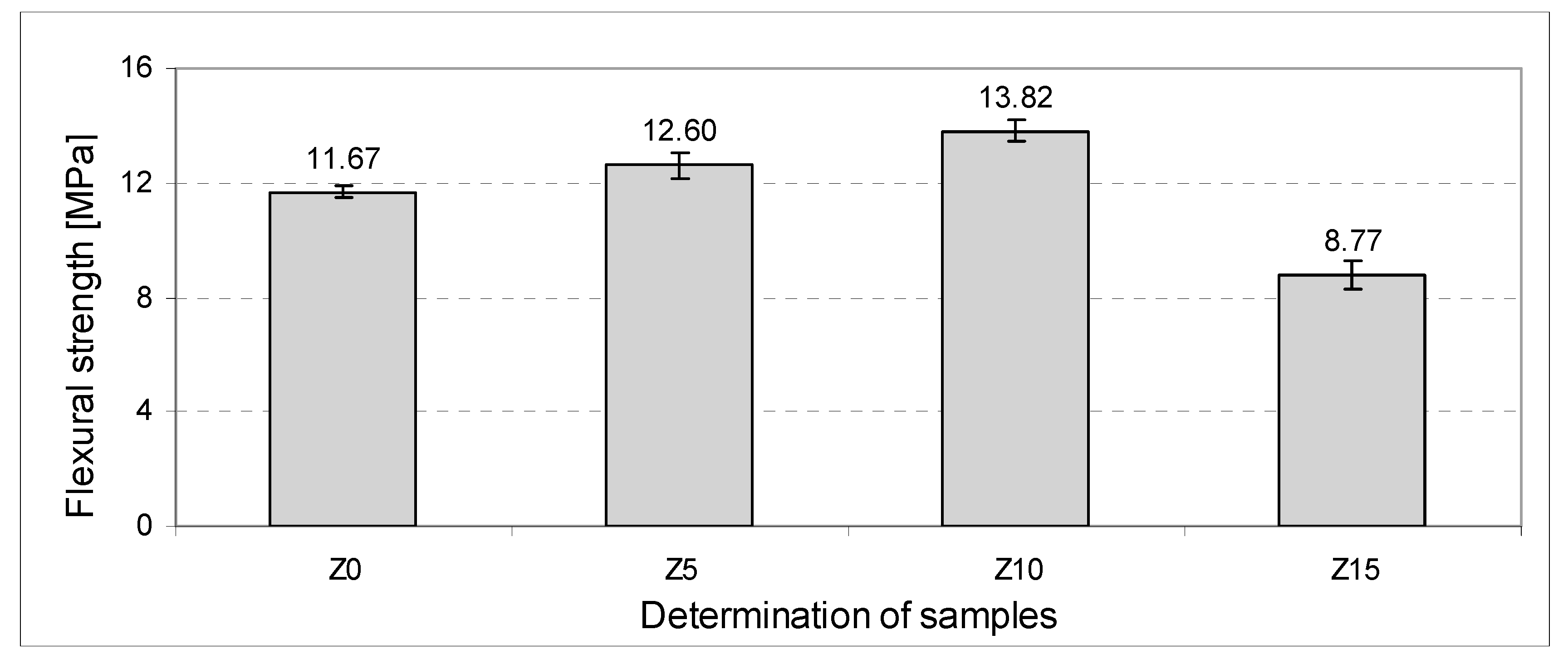

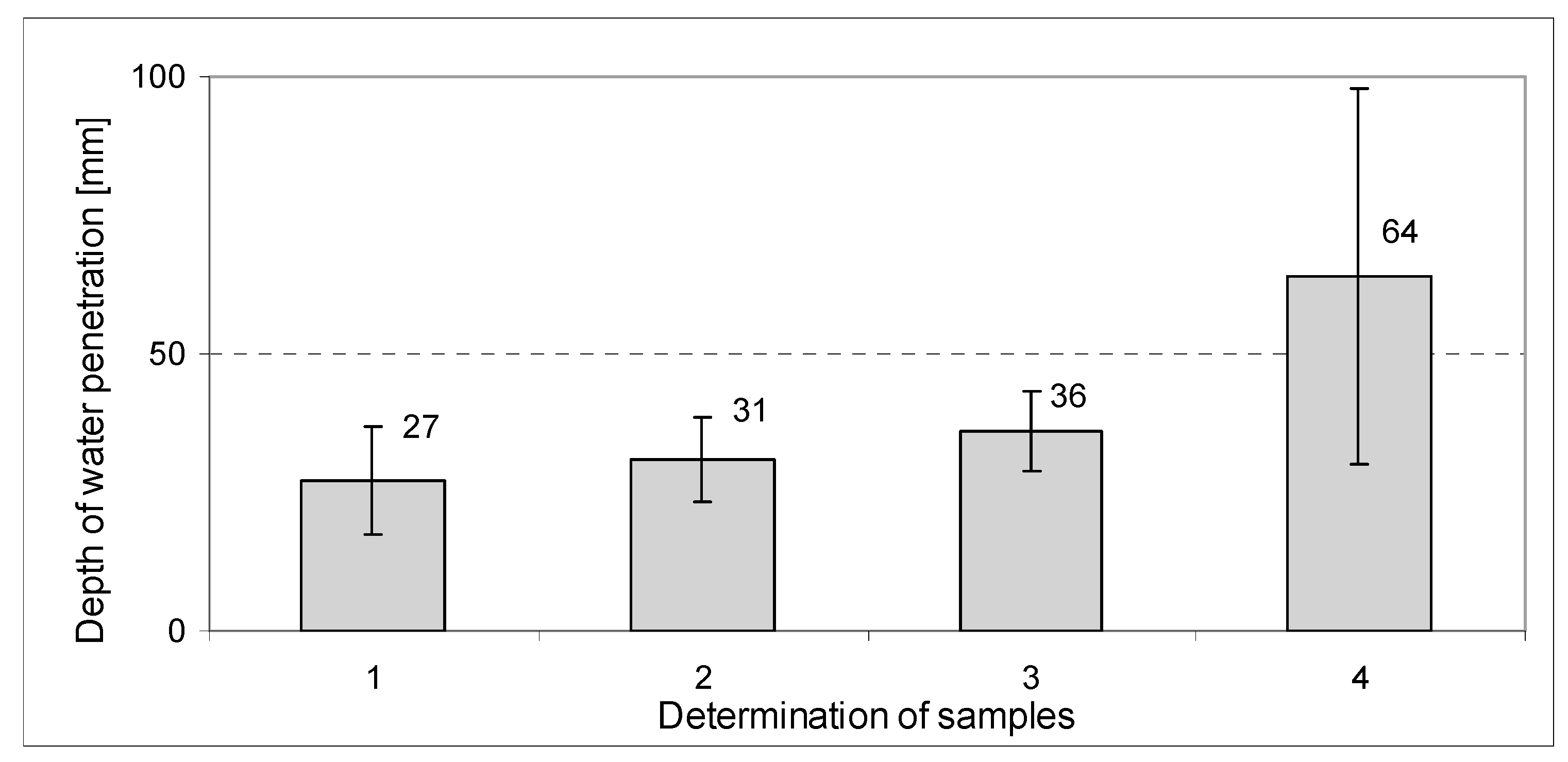

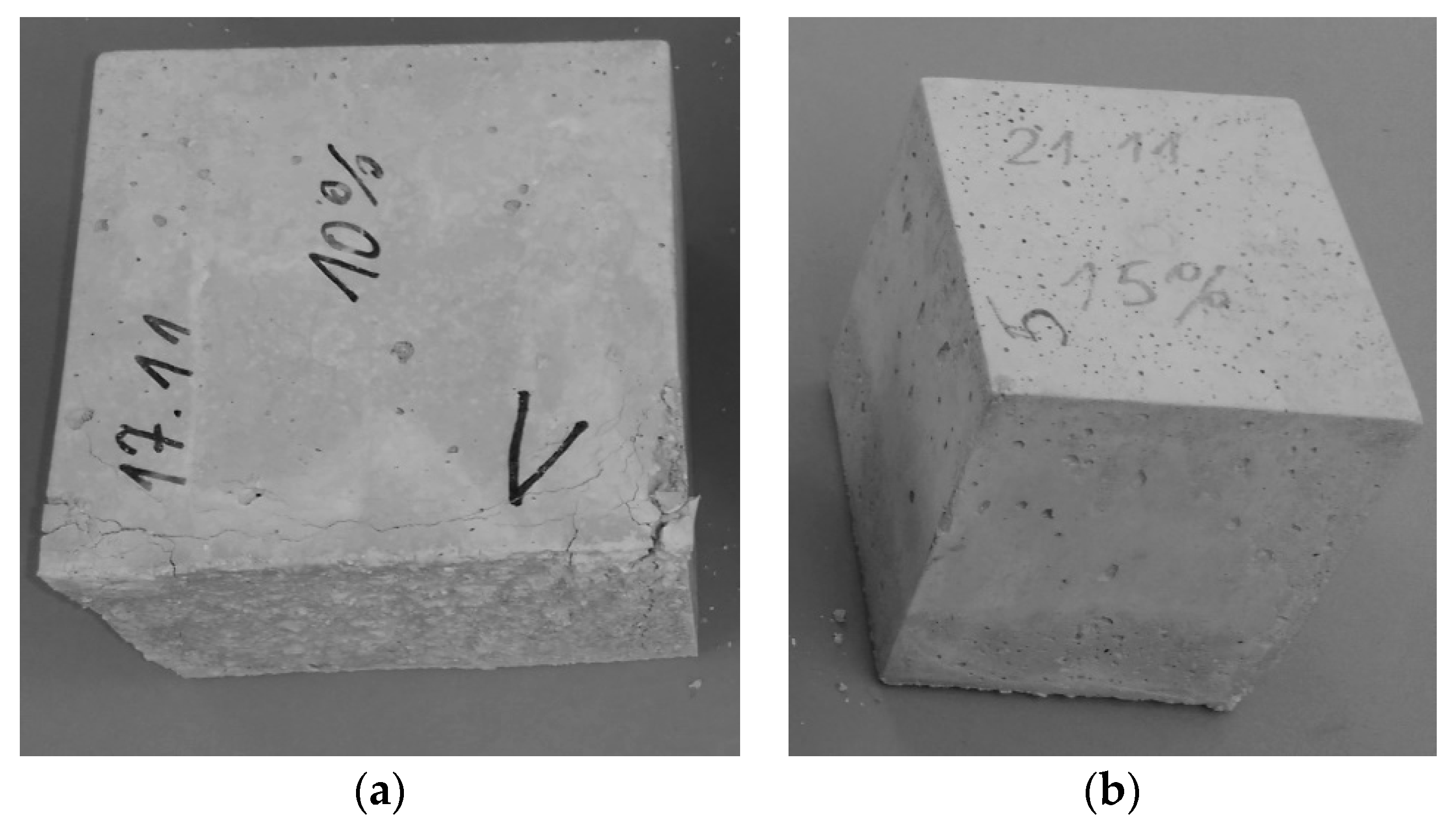
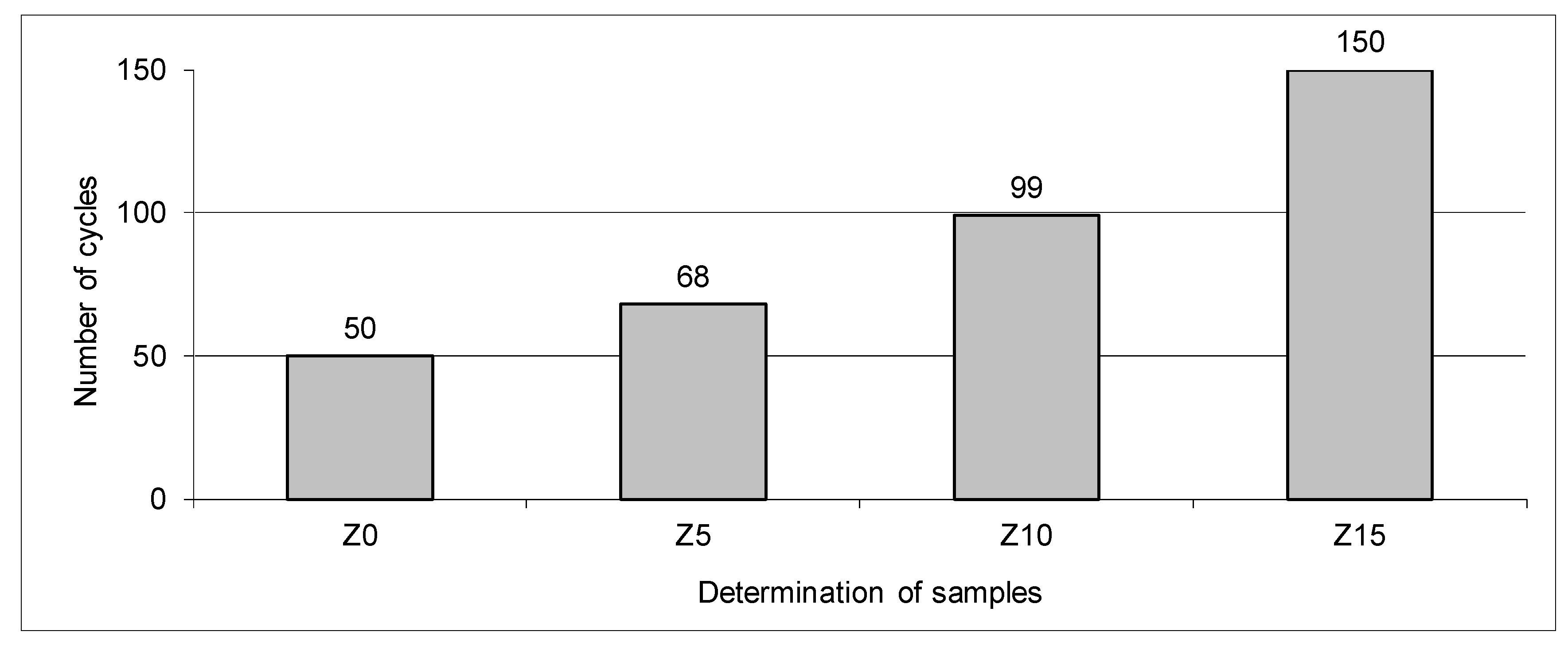
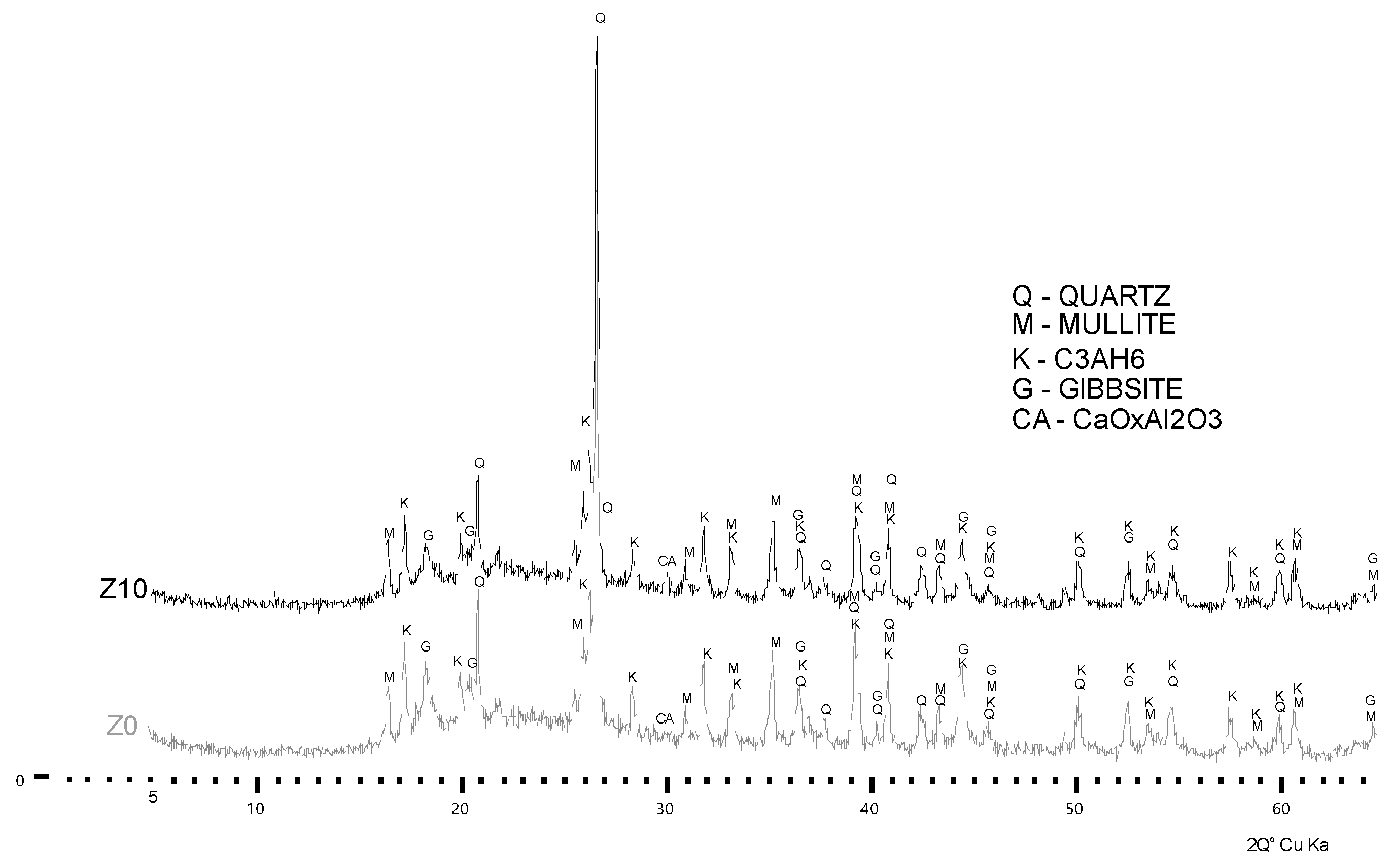
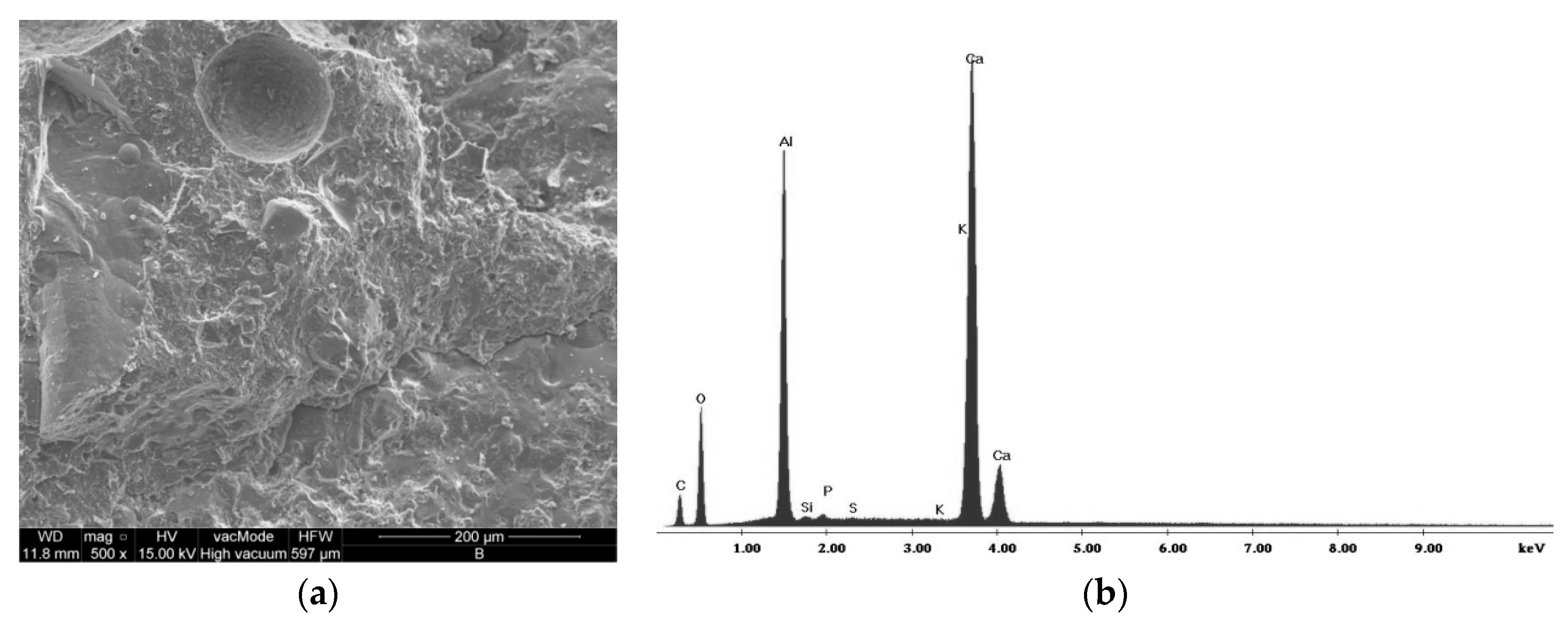
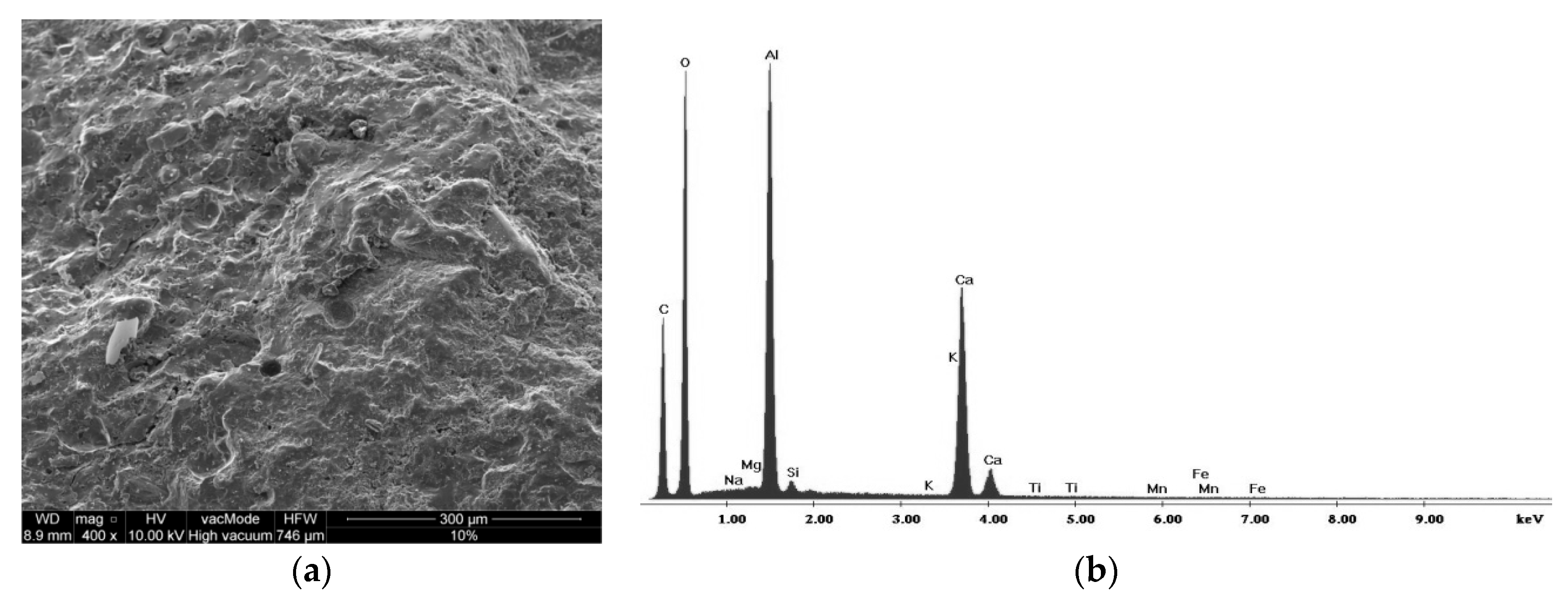
| Determination | Contents of Compounds [%] | |||||||
|---|---|---|---|---|---|---|---|---|
| Na2O | MgO | Al2O5 | SiO2 | TiO2 | K2O | CaO | Fe2O3 | |
| Analysis of area (Figure 2) | 1.16 | - | 41.82 | 50.63 | 0.95 | 3.26 | 1.85 | 0.95 |
| Analysis of area (Figure 3) | 1.03 | 0.17 | 33.14 | 62.27 | - | 2.24 | 0.45 | 0.71 |
| Sample Designation | Z0 | Z5 | Z10 | Z15 |
|---|---|---|---|---|
| Aluminous cement Górkal 70 [kg/m3] | 488.00 | 463.60 | 439.20 | 414.80 |
| Aggregate 0–4 mm [kg/m3] | 997.14 | 997.14 | 997.14 | 997.14 |
| Aggregate 4–8 mm [kg/m3] | 398.86 | 398.86 | 398.86 | 398.86 |
| Clinoptilolite [kg/m3] | - | 24.40 | 48.80 | 73.20 |
| Water [L/m3] | 196.00 | 196.00 | 196.00 | 196.00 |
| Determination | Contents of Compounds [%] | |||||||
|---|---|---|---|---|---|---|---|---|
| Al2O5 | CaO | SiO2 | MgO | Na2O | P2O5 | SO3 | K2O | |
| Z0 | 48.23 | 50.45 | 1.05 | - | - | 0.25 | - | - |
| Z10 | 66.83 | 30.24 | 2.12 | 0.56 | 0.24 | - | - | - |
© 2019 by the authors. Licensee MDPI, Basel, Switzerland. This article is an open access article distributed under the terms and conditions of the Creative Commons Attribution (CC BY) license (http://creativecommons.org/licenses/by/4.0/).
Share and Cite
Szulej, J.; Ogrodnik, P.; Klimek, B. Zeolite Tuff and Recycled Ceramic Sanitary Ware Aggregate in Production of Concrete. Sustainability 2019, 11, 1782. https://doi.org/10.3390/su11061782
Szulej J, Ogrodnik P, Klimek B. Zeolite Tuff and Recycled Ceramic Sanitary Ware Aggregate in Production of Concrete. Sustainability. 2019; 11(6):1782. https://doi.org/10.3390/su11061782
Chicago/Turabian StyleSzulej, Jacek, Paweł Ogrodnik, and Beata Klimek. 2019. "Zeolite Tuff and Recycled Ceramic Sanitary Ware Aggregate in Production of Concrete" Sustainability 11, no. 6: 1782. https://doi.org/10.3390/su11061782





